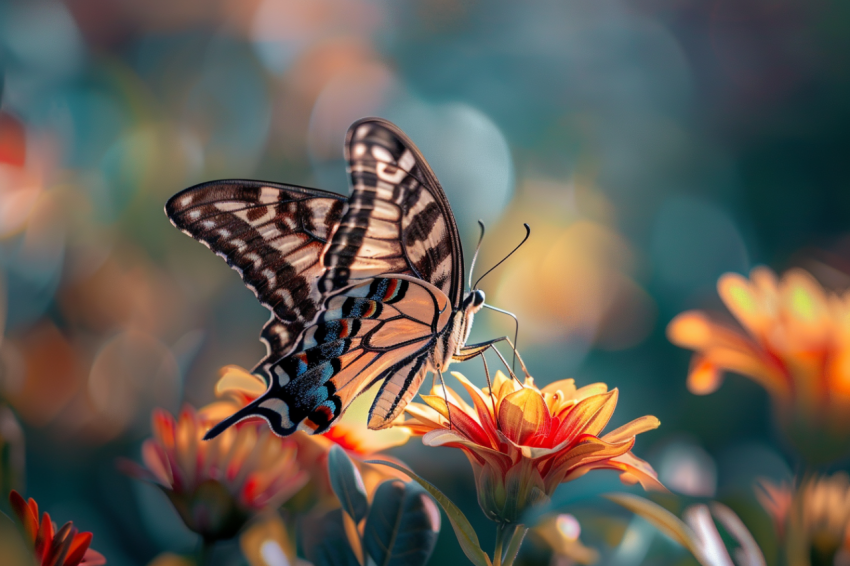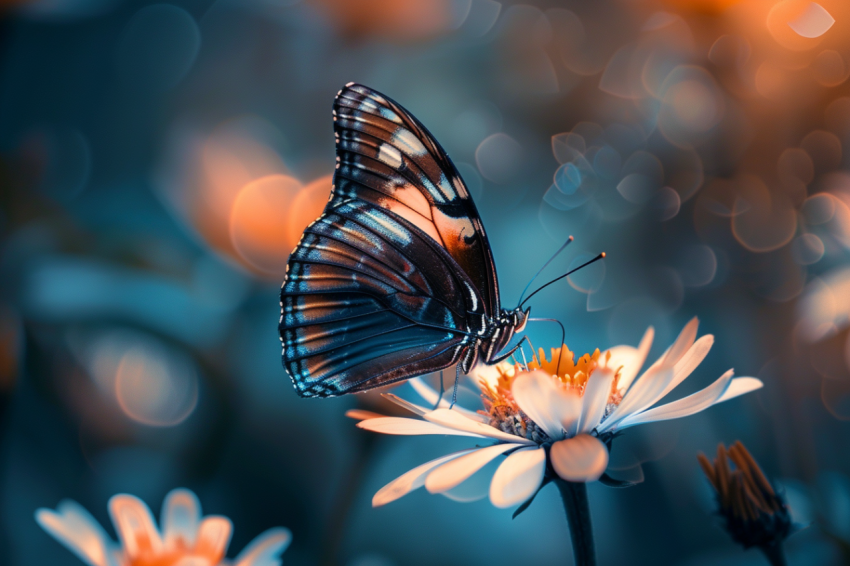











The Enchanting World of Butterflies: Metamorphosis, Migration & Beauty
Butterflies, with their vibrant colors and graceful flight, are among the most beloved insects. They belong to the order Lepidoptera, which also includes moths. Butterflies are renowned for their remarkable life cycle, involving a complete metamorphosis from a crawling caterpillar to a winged adult. This exploration delves into the captivating world of butterflies, covering their biology, behavior, diversity, and ecological significance.
1. Butterfly Biology and Anatomy:
- Exoskeleton: Like all insects, butterflies have a hard exoskeleton made of chitin.
- Body Segmentation: Their bodies are divided into three main segments: the head, thorax, and abdomen.
- Wings: Butterflies have two pairs of large, membranous wings covered in tiny scales that create their vibrant colors and patterns.
- Antennae: Butterflies have club-shaped antennae used for smelling and balance.
- Proboscis: A long, coiled tube used to suck nectar from flowers.
- Legs: Butterflies have six legs, but the front pair is often reduced and not used for walking in some families.
2. Butterfly Life Cycle (Metamorphosis):
The butterfly life cycle is a classic example of complete metamorphosis:
- Egg: Female butterflies lay small eggs, often on specific host plants that will serve as food for the hatching caterpillars.
- Larva (Caterpillar): The larval stage is a period of growth and feeding. Caterpillars have a voracious appetite and molt several times as they grow.
- Pupa (Chrysalis): The caterpillar transforms into a pupa, a resting stage where metamorphosis occurs. The pupa is often enclosed in a hardened case called a chrysalis.
- Adult (Butterfly): The adult butterfly emerges from the chrysalis with fully developed wings. The primary focus of the adult stage is reproduction.
3. Diversity of Butterfly Species:
There are over 18,000 known butterfly species worldwide, exhibiting a stunning array of colors, patterns, and sizes. Some notable families include:
- Swallowtails (Papilionidae): Large, colorful butterflies with tail-like extensions on their hindwings.
- Whites and Sulphurs (Pieridae): Often white or yellow, with some species exhibiting seasonal variations in color.
- Brush-footed Butterflies (Nymphalidae): The largest family of butterflies, including monarchs, admirals, and fritillaries.
- Gossamer-winged Butterflies (Lycaenidae): Small butterflies, often with iridescent blue or copper colors.
- Skippers (Hesperiidae): Small, fast-flying butterflies with a characteristic "skipping" flight pattern.
4. Butterfly Behavior:
- Feeding: Adult butterflies feed primarily on nectar from flowers, using their proboscis to suck up the liquid. Some species also feed on tree sap, rotting fruit, or even animal dung.
- Basking: Butterflies often bask in the sun to raise their body temperature, which is necessary for flight.
- Puddling: Some butterflies, especially males, gather at damp patches of soil or sand to obtain minerals and salts. This behavior is known as puddling.
- Courtship and Mating: Butterflies engage in elaborate courtship rituals, often involving aerial displays and the release of pheromones.
- Migration: Some butterfly species, such as the Monarch butterfly, undertake incredible long-distance migrations, traveling thousands of miles between breeding and overwintering grounds.
5. Butterfly Wing Patterns and Colors:
Butterfly wings are covered in thousands of tiny scales that create their vibrant colors and intricate patterns. These colors serve various purposes:
- Camouflage: Some butterflies have wing patterns that help them blend in with their surroundings, providing protection from predators.
- Warning Coloration: Bright, contrasting colors can signal to predators that the butterfly is toxic or distasteful.
- Mimicry: Some butterflies mimic the wing patterns of toxic species to deter predators (Batesian mimicry). Others share similar warning patterns to reinforce the signal to predators (Mullerian mimicry).
- Mate Recognition: Wing patterns can play a role in species recognition and mate selection.
6. Butterfly Pollination:
While not as efficient as bees, butterflies are important pollinators, especially for certain types of flowers. As they feed on nectar, they transfer pollen grains between flowers, aiding in plant reproduction.
7. Butterfly Conservation:
Butterfly populations face various threats:
- Habitat Loss: The destruction of natural habitats, such as meadows, forests, and wetlands, reduces the availability of food plants and breeding sites for butterflies.
- Pesticide Use: Pesticides can harm or kill butterflies directly or indirectly by reducing the availability of their food plants.
- Climate Change: Changes in temperature and precipitation patterns can affect butterfly distribution, migration patterns, and the timing of their life cycle events.
- Invasive Species: Introduced plants can outcompete native host plants, reducing the food supply for caterpillars.
8. Butterfly Gardening:
Creating a butterfly garden is a great way to support butterfly populations:
- Plant Nectar Sources: Provide a variety of flowering plants that bloom throughout the growing season.
- Include Host Plants: Plant specific host plants that caterpillars need for food.
- Provide Water Sources: A shallow dish of water with pebbles or sand can provide a drinking source.
- Avoid Pesticides: Use natural pest control methods to protect butterflies and their food plants.
9. Studying Butterflies (Lepidopterology): The scientific study of butterflies and moths is known as lepidopterology. Scientists study various aspects of butterfly biology, behavior, ecology, and evolution. Citizen scientists can also contribute to butterfly research by participating in monitoring programs and reporting butterfly sightings.
Conclusion:
Butterflies are captivating insects that play important roles in ecosystems. Their beauty, intricate life cycle, and fascinating behaviors have made them a subject of wonder and scientific study for centuries. By understanding the threats they face and taking steps to conserve their habitats, we can help ensure that these enchanting creatures continue to grace our world for generations to come.
Butterfly life cycle, butterfly metamorphosis, butterfly wings, butterfly migration, Monarch butterfly, caterpillar, chrysalis, pupa, butterfly species, butterfly conservation, butterfly gardening, host plants, nectar plants, butterfly pollination, swallowtail butterflies, brush-footed butterflies, painted lady, red admiral, viceroy, morpho butterfly, swallowtail, white and sulphurs, gossamer-winged butterflies, skippers, lepidopterology, threats to butterflies, habitat loss, pesticide use, climate change, invasive species, butterfly mimicry, warning coloration, camouflage, puddling, basking, butterfly behavior, butterfly anatomy.
